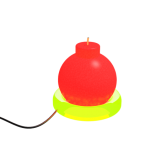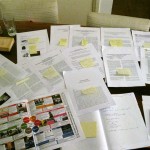FBP “Woven Worlds”
 Final Bachelor Project ‘Woven Worlds’
Final Bachelor Project ‘Woven Worlds’
Coach: ir. M.F. Versteeg
Theme: Wearable Senses
Coach feedback (Login ID Compass required)
Project Report (opens in new window)
Project description
Company Dreamsolution.nl (client) has developed an Internet portal that gives households insight in their electricity use. In order to make better use of this, a tangible extension has to be designed for households.
Concept description
The energy-bomb gives the user real-time feedback about current electricity use in understandable units and motivates the user due to the avoidance of an ‘irritating’ (virtual) exploded bomb and the social comparison feature. The length of the dynamic fuse becomes longer when the households electricity consumption is low, in order to give the user more ‘stock’. When on average higher electricity consumption is measured, the fuse will decrease length and eventually the bomb ‘explodes’. The average household’s energy use is comparable with other via the docking station, which is used while resetting. In the end, this design contributes to a benefit of the client’s web portal, since the users will be confronted with their use when the bomb has to be reset in the docking station connected with the PC.
Competencies developed:
1,2,3,6,A,B,C,D
Reflection
My main goals for this project were to have a broaden ideation phase in my project where would give me more design iterations and diversity options at every step. In addition, there should be better a consistency of designing and research; design decisions should be covered before, while and after by supported by research. What’s more, my vision and ‘signature’ as designer should be ‘woven into’ project and I wanted to learn how to use Arduino.
1. Ideas & concept
Looking at the previous assessment, my ideation process should contain more design iterations at every step that should be founded by research (see also B). Therefore one of my goals was to have a broaden ideation phase which has multiple design iterations and options at every step. In order to achieve this I used multiple ideation tools (like Random Trigger, MATEC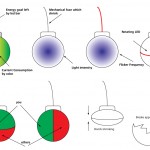 and acting out) I learned from assignments like creativity techniques and previous projects, but I also learned new tools, like ‘cherry split’ and ‘crazy combinations’ gathered from the book thinkertoys and the user centered sessions from the co-reflection assignment. However, I was stuck sometimes and I saw that pen and paper only would not give me enough inspiration to go outside the box completely, as mentioned in the coach feedback. In order to break this I learned that it is useful to look at the designs from another approach. I became aware of useful tools (acting out/looking for existing objects, actions or interactions within the context of the user/technical (Arduino) feasibility/use of metaphors/design with intent) to pull myself out, go really out of the box and to come up with new design iterations. In addition, I learned that it gave me more ‘intuitive’/logical actions and designs for inspiration when looking first at actions and then looking at which shapes and forms are ‘flowing out of these actions’ rather than the other way around. During my ideation phase I took the most interesting things from every step to continue with as input for another tool, therefore this resulted in explorative and educative ideation phase.
and acting out) I learned from assignments like creativity techniques and previous projects, but I also learned new tools, like ‘cherry split’ and ‘crazy combinations’ gathered from the book thinkertoys and the user centered sessions from the co-reflection assignment. However, I was stuck sometimes and I saw that pen and paper only would not give me enough inspiration to go outside the box completely, as mentioned in the coach feedback. In order to break this I learned that it is useful to look at the designs from another approach. I became aware of useful tools (acting out/looking for existing objects, actions or interactions within the context of the user/technical (Arduino) feasibility/use of metaphors/design with intent) to pull myself out, go really out of the box and to come up with new design iterations. In addition, I learned that it gave me more ‘intuitive’/logical actions and designs for inspiration when looking first at actions and then looking at which shapes and forms are ‘flowing out of these actions’ rather than the other way around. During my ideation phase I took the most interesting things from every step to continue with as input for another tool, therefore this resulted in explorative and educative ideation phase.
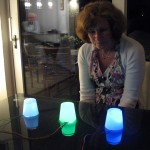 Furthermore, I learned the use of physical representations was even better to explore design directions. I learned that it is useful to try out things into practice in order to gather more solid design decisions. Like the small user test of how to use light in order to visualize data (see page 42 and 43 report and picture on the right side). Unfortunately, it was not capable of working out the three best ideas on the same level of physical existence. This would have led to more solid founding for my design decisions, by trying them out into practice.
Furthermore, I learned the use of physical representations was even better to explore design directions. I learned that it is useful to try out things into practice in order to gather more solid design decisions. Like the small user test of how to use light in order to visualize data (see page 42 and 43 report and picture on the right side). Unfortunately, it was not capable of working out the three best ideas on the same level of physical existence. This would have led to more solid founding for my design decisions, by trying them out into practice.
What’s more, I used criteria as extracted from looking at shortcomings of current household energy monitoring systems, multiple behavior change models and expert meetings. These gave me a good hold on the validate concepts, defend design decisions and to come up with multiple design iterations in every step: see pages 33-35 and 41 of the project report.
2. Integrating technology
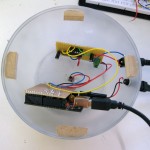 One of my goals was to extend my interactive prototyping skills using Arduino. I got some experience before with phidgets and processing. By following tutorials on the web and trying things out myself, I was able to create an interactive prototype using Arduino, as you can see the pictures below. I learned how to use Arduino as a useful tool to create interactive prototypes without the intervention of a PC. Arduino opened my eyes for new prototyping possibilities and now I am capable of creating autonomous interactive prototypes that can work on their own. Beside concept realization, Arduino can also be used as an inspiration tool (see ideas & concepts). A video of the final prototype can be viewed here.
One of my goals was to extend my interactive prototyping skills using Arduino. I got some experience before with phidgets and processing. By following tutorials on the web and trying things out myself, I was able to create an interactive prototype using Arduino, as you can see the pictures below. I learned how to use Arduino as a useful tool to create interactive prototypes without the intervention of a PC. Arduino opened my eyes for new prototyping possibilities and now I am capable of creating autonomous interactive prototypes that can work on their own. Beside concept realization, Arduino can also be used as an inspiration tool (see ideas & concepts). A video of the final prototype can be viewed here.
In addition, I extended my electronic skills. I learned how to filter ‘noise’ and to amplify an input signal so it is compatible with Arduino. Furthermore, I learned how to deal with problems concerning multiple actuators using a single power source by using voltage dividers and capacitors. As shown in the circuit on page 48 of my project report.
3. User focus & perspective
During the project, I became aware of multiple behavior change models (six weapons of influence, persuasive technology, i-change model, see pages 23 and 23 report) which can be an inspiring reference-tool as designer to take in mind for design principles.
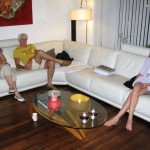 In contrast to user tests of other projects (like those of FBP “Retrieve Anthony’s Transponder” and Rhythm of Life 2.0 Project) the user test I performed during this project had a more qualitative approach. I used a useful approach combined knowledge gathered from the assignments user testing and UFP assignment and the implementation model of Grol & Wensing (see here): monitoring the user before, while and after the use of the design. I started with creating a reference value, afterwards checking my form and function assumptions and creating a dynamic playground (and observing users by the defined topic list (see page 51 report)). In the end, I evaluated the concept with the users together; what went wrong and why, how can I improve it? Unless this approach would not give answers to long-term effects, it was very effective to check the aim of my design and ‘tweaks’ for my design.
In contrast to user tests of other projects (like those of FBP “Retrieve Anthony’s Transponder” and Rhythm of Life 2.0 Project) the user test I performed during this project had a more qualitative approach. I used a useful approach combined knowledge gathered from the assignments user testing and UFP assignment and the implementation model of Grol & Wensing (see here): monitoring the user before, while and after the use of the design. I started with creating a reference value, afterwards checking my form and function assumptions and creating a dynamic playground (and observing users by the defined topic list (see page 51 report)). In the end, I evaluated the concept with the users together; what went wrong and why, how can I improve it? Unless this approach would not give answers to long-term effects, it was very effective to check the aim of my design and ‘tweaks’ for my design.
6. Form & Senses
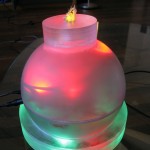 While creating the prototype, I increased my design realization competencies. I learned how to use the laser-cutting machine, which enables me to create very precise building blocks out of plastic, glass, wood, metal or textile for physical designs. In addition, I became aware how to use an abrasive blasting-machine in order to smooth a rough surface, roughen a smooth surface, shape a surface or remove surface contaminants. The picture on the right side shows the final design, made using these educated techniques.
While creating the prototype, I increased my design realization competencies. I learned how to use the laser-cutting machine, which enables me to create very precise building blocks out of plastic, glass, wood, metal or textile for physical designs. In addition, I became aware how to use an abrasive blasting-machine in order to smooth a rough surface, roughen a smooth surface, shape a surface or remove surface contaminants. The picture on the right side shows the final design, made using these educated techniques.
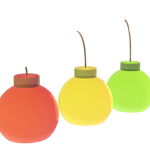
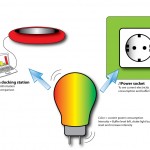 In addition, I got more experience in creating aesthetic visuals using the new flamingo NXT render (plug-in for Rhinoceros 3D modeling software). This includes the different variables of materials, lighting methods, transparency and ray tracing. Furthermore, I got more skilled in using Adobe’s Illustrator as you can see in the pictures below. Both activities enabled me to create better visuals for (re)presentation purposes (see and click pictures on the left side).
In addition, I got more experience in creating aesthetic visuals using the new flamingo NXT render (plug-in for Rhinoceros 3D modeling software). This includes the different variables of materials, lighting methods, transparency and ray tracing. Furthermore, I got more skilled in using Adobe’s Illustrator as you can see in the pictures below. Both activities enabled me to create better visuals for (re)presentation purposes (see and click pictures on the left side).
A. Multi-disciplinary teamwork
In my opinion, it is important to check design decisions with experts and users. During the project, I was able to contact multiple people concerning different expertise what supported me in design decisions (like the visit TU Delft, psychologist dr. Michel Handgraaf, interaction-design expert dr. Stephan Wensveen). However looking critic to these activities I think the expert meeting with dr. Jaap Ham, from the faculty of Industrial Engineering & Innovation Sciences, could have been better. Unless I prepared myself, the outcome was not that much detailed as expected. The next time I have to prepare myself better by setting a concrete aim and questions or select a more useful moment in the design process.
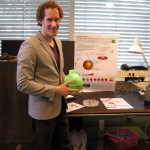 As mentioned in the feedback too, I had to find a balance between the interests of all my stakeholders. I learned that I have to choose sometimes between the interests of all the stakeholders supporting the values of the final design (see more in competency area C). In the end, during the final exhibition the demonstration of an interactive prototype was appreciated a lot by visitors and enabled me to create a dialogue with the design and the visitors. Prof.dr.ir. Loe Feijs even give me ‘his compliments’ for my final design.
As mentioned in the feedback too, I had to find a balance between the interests of all my stakeholders. I learned that I have to choose sometimes between the interests of all the stakeholders supporting the values of the final design (see more in competency area C). In the end, during the final exhibition the demonstration of an interactive prototype was appreciated a lot by visitors and enabled me to create a dialogue with the design and the visitors. Prof.dr.ir. Loe Feijs even give me ‘his compliments’ for my final design.
B. Design & research process
Looking at the previous assessment, research and design phases should be integrated better. This time I achieved this goal by extracting design criteria from research and trying things out by myself as design criteria input as showed on page 25 of my project report.

Looking at the design process, I spend too much time on the research and ideation phases. Unless it was a very explorative and educative design process that gave me good founding for design iterations and decisions, I think I spend too much time on becoming concrete again (since I got stuck sometimes, see 1. ideas & concepts). This resulted in a shortage of time for the subsequent phases like concept development and user testing, which are both more related towards my vision as designer. I can conclude that a broaden ideation phase is very useful to open up my eyes for out of the box design iterations, but this time I exaggerated a bit. Next time I should set a time limit on this design step. The visual above illustrates the design process of this project (red) and an improved design process (blue).
C. Self-Directed and Continuous Learning
Reviewing my project, it is a pity I spend so much time at concreting an idea. I think this is caused by the fact that I was very unsure to go to one idea too quickly, which happened during my previous project. Taking the book ‘Understanding design’ of Kees Dorst as a reference, a designer should use his hands, head and heart. Hands and the head were both used in this project when  creating physical design iterations based on research. Nevertheless, my heart was missing sometimes. It would have been better to cut the long lasting think troughs and just pick one based on intuition and try it out myself see what concept works the best. I should take this in mind for the upcoming project. In addition, as also mentioned in the coach feedback I was stuck sometimes. Looking back it would have been better to take distance from the current activity and view it from a broader perspective. Next time I will force myself to do this every period (i.e. every two weeks). Furthermore, I spend too much time of figuring out certain technology myself. Next time I should set myself a maximum and not be so selfish not to contact an expert, since I have to divide my time over all the aspects of designing. Mentioning my previous assessment form, my vision as designer should be integrated better in the project and my ‘signature’ as designer should be ‘woven into’ the design. In my opinion, the energy-bomb design fits very well concerning my vision and identity as designer. The design supports households in reducing their environmental footprint using a design that supports users in their daily lives. In addition, I was capable of creating an interactive prototype and testing it out in practice, which is one of my strong competencies.
creating physical design iterations based on research. Nevertheless, my heart was missing sometimes. It would have been better to cut the long lasting think troughs and just pick one based on intuition and try it out myself see what concept works the best. I should take this in mind for the upcoming project. In addition, as also mentioned in the coach feedback I was stuck sometimes. Looking back it would have been better to take distance from the current activity and view it from a broader perspective. Next time I will force myself to do this every period (i.e. every two weeks). Furthermore, I spend too much time of figuring out certain technology myself. Next time I should set myself a maximum and not be so selfish not to contact an expert, since I have to divide my time over all the aspects of designing. Mentioning my previous assessment form, my vision as designer should be integrated better in the project and my ‘signature’ as designer should be ‘woven into’ the design. In my opinion, the energy-bomb design fits very well concerning my vision and identity as designer. The design supports households in reducing their environmental footprint using a design that supports users in their daily lives. In addition, I was capable of creating an interactive prototype and testing it out in practice, which is one of my strong competencies.
D. Descriptive and mathematical modeling
During the project I performed so much research that I sometimes drowned in the research. Some papers had conclusions that were in contrast to others. In order to get more structure I decided to spread out all the papers around the floor and to place notes on them that summarized to most important founding. I learned that this method supported me to pull myself out and keep complex phases organized. See picture on the right. In addition I learned how to use the Arduino programming code in order to create complex “artificial intelligence” for interactive prototypes.
